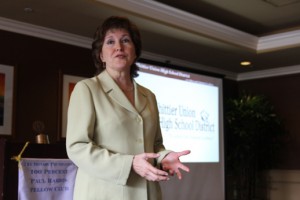
Whittier Union High School District Superintendent Sandra Thorstenson addresses the Whittier Sunrise Rotary Club on June 18, 2013.
Whittier native Thorstenson delivers poignant schools update
By Tim Traeger
Editor
411whittier.com
WHITTIER – Whatever it takes.
That’s the mantra aptly delivered recently before about 25 members of the Whittier Sunrise Rotary Club at Friendly Hills Country Club.
Sandra Thorstenson, superintendent of the Whittier Union High School District, is the ultimate care-taker for five high schools, an adult school and literally thousands of students, teachers and staff in Whittier. She knows what is needed for students to succeed in a constantly changing world climate under stringent state guidelines while high-wiring under economic tightropes.
In the Whittier native’s message to Rotarians, she said the single biggest impediment to classroom success these days is that her instructors are forced to “teach to the test” under guidelines set forth by “No Child Left Behind” legislation.
“There were some really good things about ‘No Child Left Behind.’ There were some really horrible things about ‘No Child Left Behind,’” Thorstenson said on June 18, 2013.
“The whole teaching to the test thing, it is miserable. There is too much testing. It’s overkill. Accountability is important, and we believe in it and embrace accountability, but it’s overkill. When you think about the number of days the kids are actually testing and how much instruction they’re losing out on, it’s absolutely ridiculous.”
However the 12-year superintendant said there is hope, with pain.
“There are a group of districts in the state called CORE that have an application to waive ‘No Child Left Behind’ because it really is a huge waste of money right now. School districts can fall into PI, Program Improvement, because special-ed kids don’t meet the bar. You’re not going to be able to do that. Not every kid is going to be able to be above average. It’s statistically impossible. In the beginning, everyone was able to get over the bar. But every year the bar keeps growing higher, faster and faster.”
Thorstenson, who attended Bell Elementary, Dexter Junior High, Whittier High School and Whittier College, has been living in Whittier since she was 5. The former Sandy Sanchez has seen education morph over a successive career spanning decades with stints at Pioneer, Cal and Santa Fe high schools.
“I am a home-grown Whittierite,” she said.
“So you can’t have every single kid jump the same high bar. If you have a kid who’s disabled and you want them to jump over the same bar as a star athlete, it’s just not going to happen.
“So you have to put all this money into paying for things that are ridiculous and a waste of money. As miserable as ‘No Child Left Behind’ is now, the concept makes sense. But the devil is in the details and this is not serving the kids well now.
“New common CORE state standards are coming in. They are absolutely wonderful. Forty-five states have signed onto it. It’s going to be tough. Kids’ scores across the whole 45 states are going to drop. But that’s OK because test scores are not what matter most. Kids growing and learning and being better prepared for their future is what matters most.”
One might say the “CORE” of her message was enthusiastic hope.
“We’re going to have more kids ready for college and more kids ready for careers because the common CORE is so much better than what we have with ‘No Child Left Behind.’ Common CORE requires kids to think much more critically. To really analyze and interpret. To be able to apply their learning to lots of real-world applications. Right now there is too much testing and there’s too much having to memorize. Kids are not going to be able to use that in the future.
“Under common CORE, our test scores are going to drop. But it’s OK. As long as our kids continue to grow and they’re better prepared, that’s what matters most.”
Thorstenson’s district is the second largest employer in Whittier behind PIH Health, formerly known at Presbyterian Intercommunity Hospital. The district employs 1,500 people, 1,200 of them full-time.
“Our demographics over time have really changed tremendously. My last name is Thorstenson but I’m not Norwegian. I happened to fall in love with a Norwegian boy a long time ago. I am 100 percent Hispanic. Our neighborhood was not very affluent. But what really mattered is we had a strong upbringing and very strong faith. And that’s what a lot of kids don’t have. Even if they do live in Friendly Hills, they might not have that tight family structure. It really doesn’t matter what the demographics are, if they have one healthy parent who is really committed to them, they’re going to be fine.
“But there are some kids who don’t have that. Our job, our purpose, is to ensure we make up for that. Some kids have huge opportunity gaps. We are working really, really hard to reduce those gaps. We are blessed in our district with the most amazing community with people like you, who are so service-oriented. We have all these churches, all these service clubs, we have all these non-profits.
“When I talk to my colleagues and I tell them about this interdependence we have in this community and how that really serves our kids, they marvel at that. Because it’s very unusual. I think that’s the reason we’ve been able to be so successful,” she said.
Indeed.
U.S. News & World Report has listed the WUHSD in the top school districts in the nation, doling out gold, silver and bronze metals. More than 4,000 school representatives from across the nation and the globe have visited to try and emulate its successes.
“You can’t just try to replicate this. It starts with the culture, the foundation. Make sure you have people who are collaborative, who share best-practices, who believe in kids,” Thorstenson said. “You’ve got to have quality staff. And to get the best staff, you have to offer competitive salaries. The third leg of the stool is you have to have a helpful, respectful culture. The (school) board, the administration and the employee administrations all work together. The results are seen in the kids’ achievement.”
Despite a disproportionate number of current students floating under the poverty line, Thorstenson said, “Everybody’s going to start at a different level. We don’t expect our brand-new teachers to be at the same level our more experienced teachers are. But we also want to see the same passion from both ends of the spectrum. We want to see the same commitment to continual growth.”
Tim Traeger is a Whittier resident and former editor of the Whittier Daily News. Write to him at editor@411whittier.com, call 626-646-7352 or Tweet to @411whittier.com



Leave a Reply
You must be logged in to post a comment.